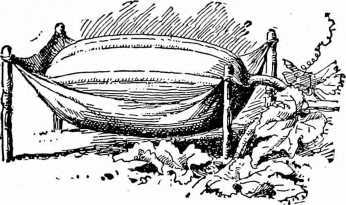Chapter 29. Growing Some Minor Vegetables
Description
This section is from the book "Pictorial Practical Vegetable Growing", by Walter P. Wright. Also available from Amazon: Pictorial Practical Vegetable Growing.
Chapter 29. Growing Some Minor Vegetables
There are certain vegetables which, the average Britisher either does not care for, or does not consider equal to his stock crops. Yet some of these "minors" of the kitchen garden are well worth growing.
Cardoon
The midribs of the inner leaves of this Globe Artichoke-like plant are delicious, and the Continentals know it, if we don't. The seeds are sown in April, the plants thinned, and eventually put out in rich soil. In light land trenches are made. In August the leaves are drawn together, made secure, and the plants earthed up. The stems then blanch.

Fig. 90. A Giant Marrow.
The fruit is supported by a piece of netting to keep it clear of the ground, and prevent it being damaged or soiled before the show.
Garlic
This white-bulbed sister of the Onion, Leek, and Shallot may be grown exactly like the last named.
Gourds and Pumpkins
A large tribe, most ornamental, but some useful. Seeds of several species are offered by the leading seedsmen, and may be treated like Vegetable Marrows. The Large Yellow, Ohio Squash, and Turk's Cap are three of the most popular.
Horseradish
Usually propagated by "thongs" - pieces of root as thick as a penholder, and 6 inches to 1 foot long. These may be planted in spring, either on the level, or diagonally in a mound of soil 2 feet high. The latter plan is good because the crop is kept under control. In the ordinary way it is apt to become a nuisance.
Kohl Rabi
A capital substitute for Turnips, though not often grown in the kitchen garden. In dry summers a crop of Kohl Rabi can often be got when Turnips fail. Treat them like Turnips.
Maize (Indian Corn)
Our American cousins have taught us the value of this crop, and we owe them a debt of gratitude for the lesson. Successions may be secured by sowing seed in pots and boxes in March, and out of doors in April and May. The rows should be 5 feet apart, and the plants 18 inches asunder. The soil must be deeply tilled and rich. The cobs, or lower heads, are delicious if gathered and cooked before becoming hard. Henderson's and Early Dwarf Sugar are two of the best varieties.
Salsify (Vegetable Oyster)
This vegetable really ought to be grown far more than it is. People are too apt to dismiss it as a sort of inferior Parsnip. It is nothing of the kind, of course. When well cooked it has a flavour of its own, and that good. Moreover, it is as good cold as hot, perhaps a little better. Sow in drills 1 foot apart in April, thin to 9 inches asunder, and lift and store like Beet in October.
Scorzonera
This purple root is liked by many, and it may be grown just like a Parsnip. It is hardier than Salsify.
Shallot
A most valuable crop and one that seems to be growing in favour, especially for pickling. There is no trouble in raising a stock from seed, but for quick returns plant bulbs, or "cloves" as they are often called, in well worked ground in February. Bury them half their depth, and do not let the soil under them be hard, otherwise they will be forced out of the ground when the roots strike down. Late planting is bad. Lift and ripen in July.
Spinach
A useful "catch" crop, coming in well between rows of Peas. The round-seeded is often spoken of as Summer, and the prickly-seeded as Winter, Spinach, but, as a matter of fact, the round is just as good for winter as the prickly, and it is probable that the round-seeded sort, known as Victoria, is the best for all purposes. A rich, well-tilled soil is necessary, and thinning should be practised, for if the plants are crowded they will run to seed. Sow from February to September for successions.

Fig. 91. How To Propagate Horseradish.
C, thin, straight root for planting, furnished with a crown; thin root fibres on the side of the stem, to be removed with a knife before planting, to prevent forking later on.
D, root ready for planting, with thin side roots scraped off.
E, roots planted 9 inches apart in rows: 1, surface soil; 2, 3 or 4 inches of soil between crown and surface.
Continue to:


